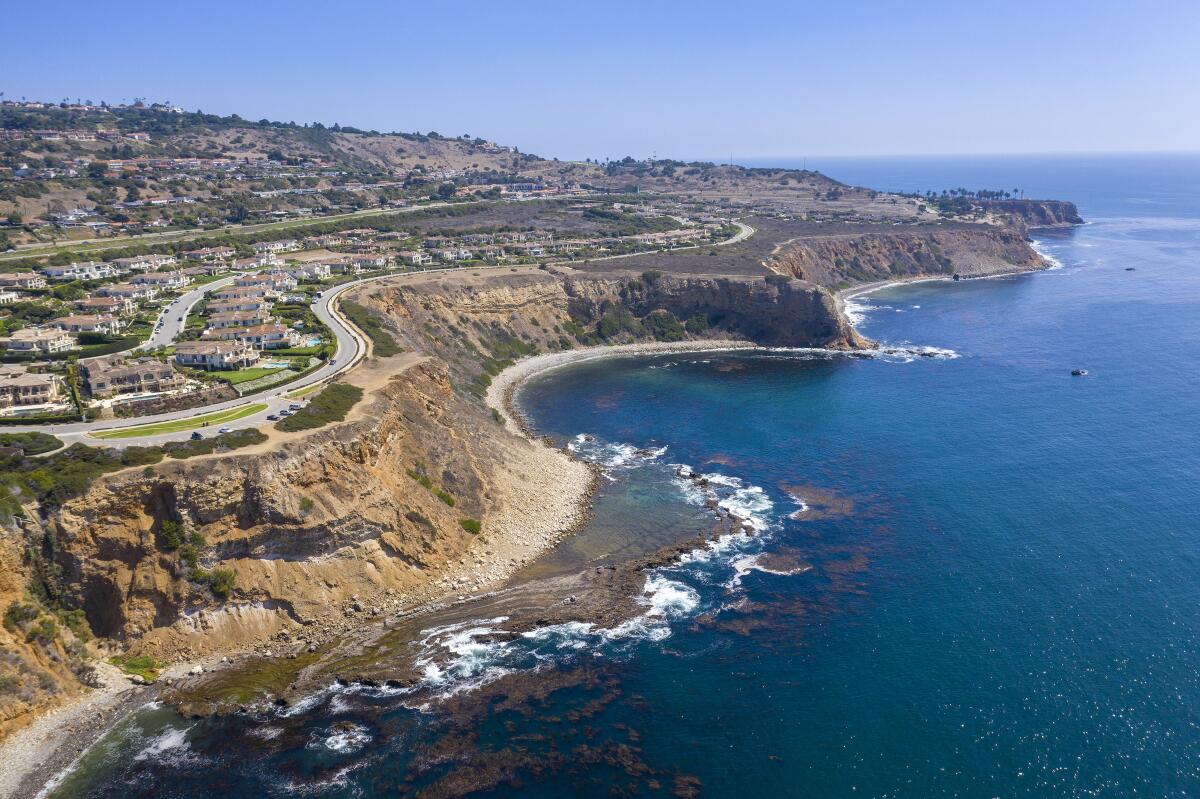Fault along L.A., O.C. coast could unleash huge earthquake on scale of San Andreas, study shows

- Share via
A fault system running nearly 70 miles along the coast of Los Angeles and Orange counties has the potential to trigger a magnitude 7.8 earthquake, according to a new study that is the latest to highlight the seismic threats facing Southern California.
Known as the Palos Verdes fault zone, the system runs deep beneath the Palos Verdes Peninsula. It previously was thought to be a segmented network of smaller faults, but a closer look by scientists at Harvard University suggests it’s a system of interconnected, closely spaced planar fractures stretching from the Santa Monica Bay to the waters off Dana Point.
The analysis determined the fault system, which runs beneath numerous neighborhoods as well as the ports of Long Beach and L.A., has a much larger surface area that could rupture in the same seismic event, making it capable of a far more powerful quake than was previously known.
Scientists found the fault could produce a quake of a magnitude comparable to one from the San Andreas fault. Earlier estimates said the fault zone could generate up to a magnitude 7.4 earthquake, but the new study shows it could produce a quake as strong as 7.8.
The difference may be only a few decimal points, but an earthquake’s energy is measured exponentially. According to the U.S. Geological Survey, a magnitude 7.8 quake produces quadruple the energy of a magnitude 7.4.
The guide to earthquake readiness and resilience that you’ll actually use.
In a worst-case scenario, the Palos Verdes fault system could unleash a quake that combines the most destructive qualities of the 1994 Northridge earthquake, a magnitude 6.7 temblor, and the 7.1 Ridgecrest quake that struck in 2019, said John H. Shaw, a professor of structural and economic geology at Harvard University and one of three authors of the new study.
The Northridge quake, which killed 57 people, had a devastating combined side-to-side and up-and-down motion that proved especially destructive to structures. That same combined lateral and vertical movement of faults is possible along the Palos Verdes network.
The Ridgecrest quake was a prolonged series along multiple interconnected fault lines, similar to those of the Palos Verdes system.
“Rather than one line in the map, we could see a rupture [series] that could occur in a wide area,” Shaw said of a major quake along the Palos Verdes fault zone. Aftershocks would be like falling dominoes, he said.
James Dolan, an Earth sciences professor at USC who reviewed the Harvard report, said the study is “by far the most detailed look we’ve had of the internal structure and connectivity of the Palos Verdes fault system.”
Scientists had previously been able to study only portions of the Palos Verdes fault system, which runs mostly underwater. But Shaw and coauthors Franklin D. Wolfe and Andreas Plesch pieced together previous studies as well as information from petroleum companies’ drilling and ground sensors, which Shaw and his colleagues used to create a new model of the fault zone.
Oil studies can be helpful to earthquake scientists because they offer insights into how the Earth looks below the surface, where earthquake faults lie.
“Historically, this fault has been seen as a segmented fault — lots of little pieces,” Shaw said. “This seemed like a structure that wasn’t going to rupture in one big earthquake.”
The new study, however, suggests the system is connected, stretching 68 miles and running under southwestern Los Angeles County and the ports of L.A. and Long Beach and along the Los Angeles and Orange county coasts.
The study, published by the Bulletin of the Seismological Society of America, also found the Palos Verdes fault slips at a much faster rate than most active fracture zones in Los Angeles County, moving 1 to 6 millimeters a year. More than 50 active faults run under L.A. County, and the majority move 1 millimeter or less annually, Shaw said.
As faults slip, that energy is stored over time, Shaw said, adding that the accumulating strain is waiting to rupture and eventually is unleashed in the form of earthquakes.
Before we can prepare for the Big One, we have to know what “one” is. Here’s a basic primer on the science of earthquakes.
The effects of a magnitude 7.8 earthquake — which would be 45 times stronger than the Northridge quake — depend on the fault’s location.
A quake of that magnitude on the southern San Andreas fault, rupturing between the Salton Sea near the Mexico border and passing through Palm Springs and into Lake Hughes, north of Santa Clarita in L.A. County, could cause 1,800 deaths, with hundreds killed in building collapses, according to a simulation of such a temblor released by the USGS in 2008.
Under the simulation’s scenario, freeways linking the region to Las Vegas and Phoenix could be destroyed, as could the aqueducts that bring in most of L.A. County’s water. Vulnerable pipelines carrying fuel and natural gas and overhead electricity lines through the Cajon Pass in San Bernardino County could explode, threatening the power grid.
Such a massive earthquake occurring in our lifetime is especially plausible because the San Andreas is the fastest-moving fault in the state, slipping at a rate of 15 to 35 millimeters a year. Scientists have likened it to someone driving at unsafe speeds — those are the ones most likely to get into a collision.
The last time Southern California was struck by a quake as powerful as a magnitude 7.8 was in 1857, when the San Andreas fault ruptured from Monterey County through the San Gabriel Mountains north of Los Angeles and into the Cajon Pass. Seismologists estimate the southern San Andreas fault is capable of a magnitude 8.2 earthquake.
On one section of the San Andreas fault along the Grapevine, scientists have found evidence that major earthquakes happen there on average every 100 years. But the gap between quakes can vary: Over a 1,000-year period, there was once a gap of 20 years between major quakes and once a gap of 200 years.
In contrast, the Palos Verdes fault zone has not produced a big earthquake during the same time period. The area most recently has generated quakes of magnitude 2 to 3, barely enough to be felt by most people.
Scientists haven’t fully explored the ramifications of a magnitude 7.8 quake on the Palos Verdes fault zone. But the USGS has studied the implications of a less powerful, magnitude 7.3 quake there, and it could still be destructive. Such a quake could kill more than 200 people and destroy more than 2,000 buildings. It could liquefy the artificial land beneath the nation’s largest port complex and cause extensive damage to infrastructure.
Caltech seismologist Egill Hauksson said a 7.8 quake on the Palos Verdes fault would devastate Southern California. But Hauksson, one of the region’s most respected experts in this field, said it also would be unlikely to occur in our lifetime.
“It would be pretty devastating, but it’s pretty unlikely,” Hauksson said. “It’s not a very active fault.”
People are much more important than kits. People will help each other when the power is out or they are thirsty. And people will help a community rebuild and keep Southern California a place we all want to live after a major quake.
Likewise, Shaw said the new information is not a major cause for alarm, especially in earthquake-prone California.
“California is already a center for earthquakes, and the danger for a large earthquake exists constantly,” he said. “This helps us ... understand this particular fault system location, where large earthquakes might occur. It helps us understand the hazards these earthquakes might create so we can prepare for them better.
“Location matters. And while future earthquakes of the San Andreas fault are concerning and we should be prepared, smaller earthquakes that are in an urban environment have shown to make as much — if not more — hazards.”
Times staff writer Rong-Gong Lin II contributed to this report.
- Share via
Watch L.A. Times Today at 7 p.m. on Spectrum News 1 on Channel 1 or live stream on the Spectrum News App. Palos Verdes Peninsula and Orange County viewers can watch on Cox Systems on channel 99.
More to Read
Sign up for Essential California
The most important California stories and recommendations in your inbox every morning.
You may occasionally receive promotional content from the Los Angeles Times.















